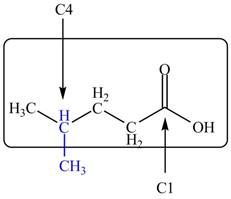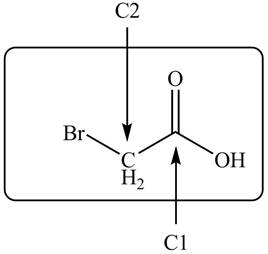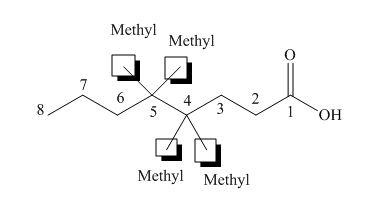
Give the IUPAC name for each compound.
a.
 h.
h. ![]()
b.
c.  f.
f.  i.
i. 
d.
 j.
j. 
(a)
Interpretation: The IUPAC name for each compound is to be stated.
Concept introduction: International Union of Pure and Applied Chemistry gave guidelines to write the chemical name of molecules. One should follow the given three steps to derive the structure of the compound from its IUPAC name. The first step involves the identification of the parent name and the functional group found at the end of the name. The second step is numbering of carbon skeleton in either direction. The third step is the addition of substituents at appropriate carbon atoms.
Answer to Problem 19.28P
The name of the compound is
Explanation of Solution
The structure of the given compound is shown below.

Figure 1
The above compound has a chain of five carbon atoms. The carboxylic acid is present as a functional group in the compound. One methyl group is present at the fourth carbon atom. Therefore, the name of the compound is
The name of the compound is
(b)
Interpretation: The IUPAC name for each compound is to be stated.
Concept introduction: International Union of Pure and Applied Chemistry gave guidelines to write the chemical name of molecules. One should follow the given three steps to derive the structure of the compound from its IUPAC name. The first step involves the identification of the parent name and the functional group found at the end of the name. The second step is numbering of carbon skeleton in either direction. The third step is the addition of substituents at appropriate carbon atoms.
Answer to Problem 19.28P
The name of the compound is
Explanation of Solution
The structure of the given compound is shown below.

Figure 2
The above compound has a chain of two carbon atoms. The carboxylic acid is present as a functional group in the compound. One bromo group is present at the second carbon atom. Therefore, the name of the compound is
The name of the compound is
(c)
Interpretation: The IUPAC name for each compound is to be stated.
Concept introduction: International Union of Pure and Applied Chemistry gave guidelines to write the chemical name of molecules. One should follow the given three steps to derive the structure of the compound from its IUPAC name. The first step involves the identification of the parent name and the functional group found at the end of the name. The second step is numbering of carbon skeleton in either direction. The third step is the addition of substituents at appropriate carbon atoms.
Answer to Problem 19.28P
The name of the compound is
Explanation of Solution
The structure of the given compound is shown below.

Figure 3
The above compound has a chain of eight carbon atoms. The carboxylic acid is present as a functional group in the compound. Two methyl groups are present at thefourth carbon atom and two methyl groups are present at the fifth carbon atom. Therefore, the name of the compound is
The name of the compound is
(d)
Interpretation: The IUPAC name for each compound is to be stated.
Concept introduction: International Union of Pure and Applied Chemistry gave guidelines to write the chemical name of molecules. One should follow the given three steps to derive the structure of the compound from its IUPAC name. The first step involves the identification of theparent name and the functional group found at the end of the name. The second step is numbering of carbon skeleton in either direction. The third step is the addition of substituents at appropriate carbon atoms.
Answer to Problem 19.28P
The name of the compound is lithium butanoate.
Explanation of Solution
The structure of the given compound is shown below.

Figure 4
The above compound has a chain of five carbon atoms. The compound contains the salt of carboxylic acid as a functional group. Therefore, the name of the compound is lithium butanoate.
The name of the compound is lithium butanoate.
(e)
Interpretation: The IUPAC name for each compound is to be stated.
Concept introduction: International Union of Pure and Applied Chemistry gave guidelines to write the chemical name of molecules. One should follow the given three steps to derive the structure of the compound from its IUPAC name. The first step involves the identification of theparent name and the functional group found at the end of the name. The second step is numbering of carbon skeleton in either direction. The third step is the addition of substituents at appropriate carbon atoms.
Answer to Problem 19.28P
The name of the compound is
Explanation of Solution
The structure of the given compound is shown below.

Figure 5
The above compound contains cyclopentyl ring. The carboxylic acid is present as a functional group in the compound. Ethyl group is attached to first carbon atom. Therefore, the name of the compound is
The name of the compound is
(f)
Interpretation: The IUPAC name for each compound is to be stated.
Concept introduction: International Union of Pure and Applied Chemistry gave guidelines to write the chemical name of molecules. One should follow the given three steps to derive the structure of the compound from its IUPAC name. The first step involves the identification of the parent name and the functional group found at the end of the name. The second step is numbering of carbon skeleton in either direction. The third step is the addition of substituents at appropriate carbon atoms.
Answer to Problem 19.28P
The name of the compound is
Explanation of Solution
The structure of the given compound is shown below.

Figure 6
The above compound contains cyclohexyl ring. The carboxylic acid is present as a functional group in the compound. One methyl group is present at the second carbon atom and other at the fourth carbon atom. Therefore, the name of the compound is
The name of the compound is
(g)
Interpretation: The IUPAC name for each compound is to be stated.
Concept introduction: International Union of Pure and Applied Chemistry gave guidelines to write the chemical name of molecules. One should follow the given three steps to derive the structure of the compound from its IUPAC name. The first step involves the identification of theparent name and the functional group found at the end of the name. The second step is numbering of carbon skeleton in either direction. The third step is the addition of substituents at appropriate carbon atoms.
Answer to Problem 19.28P
The name of the compound is
Explanation of Solution
The structure of the given compound is shown below.

Figure 7
The above compound contains an aromatic ring. The carboxylic acid is present as a functional group in the compound. The bromogroupis attached to second carbon atom. Therefore, the name of the compound is
The name of the compound is
(h)
Interpretation: The IUPAC name for each compound is to be stated.
Concept introduction: International Union of Pure and Applied Chemistry gave guidelines to write the chemical name of molecules. One should follow the given three steps to derive the structure of the compound from its IUPAC name. The first step involves the identification of theparent name and the functional group found at the end of the name. The second step is numbering of carbon skeleton in either direction. The third step is the addition of substituents at appropriate carbon atoms.
Answer to Problem 19.28P
The name of the compound is
Explanation of Solution
The structure of the given compound is shown below.

Figure 8
The above compound contains an aromatic ring. The carboxylic acid is present as a functional group in the compound. The ethyl group is attached to fourth carbon atom. Therefore, the name of the compound is
The name of the compound is
(i)
Interpretation: The IUPAC name for each compound is to be stated.
Concept introduction: International Union of Pure and Applied Chemistry gave guidelines to write the chemical name of molecules. One should follow the given three steps to derive the structure of the compound from its IUPAC name. The first step involves the identification of theparent name and the functional group found at the end of the name. The second step is numbering of carbon skeleton in either direction. The third step is the addition of substituents at appropriate carbon atoms.
Answer to Problem 19.28P
The name of the compound is sodium
Explanation of Solution
The structure of the given compound is shown below.

Figure 9
The above compound contains the chain of six carbon atoms. The salt of a carboxylic acid is a functional group in the compound. Methyl group is attached to second carbon atom. Therefore, the name of the compound is sodium
The name of the compound is sodium
(j)
Interpretation: The IUPAC name for each compound is to be stated.
Concept introduction: International Union of Pure and Applied Chemistry gave guidelines to write the chemical name of molecules. One should follow the given three steps to derive the structure of the compound from its IUPAC name. The first step involves the identification of theparent name and the functional group found at the end of the name. The second step is numbering of carbon skeleton in either direction. The third step is the addition of substituents at appropriate carbon atoms.
Answer to Problem 19.28P
The name of the compound is
Explanation of Solution
The structure of the given compound is shown below.

Figure 10
The above compound contains a chain of ten carbon atoms. The carboxylic acid is a functional group in the compound. The methyl, isopropyl andethyl groupsare attached to third, fifth and seventh carbon atom respectively. Therefore, the name of the compound is
The name of the compound is
Want to see more full solutions like this?
Chapter 19 Solutions
Organic Chemistry
- Isooctane is the common name of the isomer of C8H18 used as the standard of 100 for the gasoline octane rating: (a) What is the IUPAC name for the compound? (b) Name the other isomers that contain a five-carbon chain with three methyl substituents.arrow_forwardDraw the structure of a molecule that fi ts each description: a. a 2 ° alcohol of molecular formula C 6H 14O b. an ether with molecular formula C 6H 14O that has a methyl group bonded to oxygen c. a 3 ° alkyl halide with molecular formula C 5H 11Brarrow_forward2. a. What is the chemical structure of naphthalene, circle functional groups different than alkane,alkene, alkyne? b. Is it polar or nonpolar? _______________________ c. What is its water solubility in g/L? _________________________arrow_forward
- a. What is the chemical structure of biphenyl, circle functional groupsdifferent than alkane, alkene, alkyne? b. Is it polar or nonpolar? _______________________ c. What is its water solubility in g/L? __________________________arrow_forward(a) (CH3)3CBr give the common name (if possible).arrow_forwardWhich alkyl halide has the highest boiling point? A. CH3BrB. CH3FC. CH3ClD. CH3larrow_forward
- What is the name of the alkene? CH3CH=CHCH=CH2arrow_forwardDraw the structure of a molecule that fi ts each description: a. a 2 ° alcohol of molecular formula C 6H 12O b. a cyclic ether with molecular formula C 5H 10O c. a 1 ° alkyl halide with molecular formula C 5H 11Clarrow_forwardDefine the Properties of Alkyl Halides ?arrow_forward
- Write the common name for the ether. CH3CHOCHCH3 I I CH3 CH3 methyl groups are attached to carbon 2 and 3arrow_forwardi. Why is the boiling point of the aldehyde greater than that of the alkane? ii. Why is the boiling point of alcohol the highest? iii. Explain why the solubility of aldehydes and alcohols falls as the molecules get bigger.arrow_forward2-pentanol+LiAlH4arrow_forward
 Chemistry by OpenStax (2015-05-04)ChemistryISBN:9781938168390Author:Klaus Theopold, Richard H Langley, Paul Flowers, William R. Robinson, Mark BlaserPublisher:OpenStax
Chemistry by OpenStax (2015-05-04)ChemistryISBN:9781938168390Author:Klaus Theopold, Richard H Langley, Paul Flowers, William R. Robinson, Mark BlaserPublisher:OpenStax Chemistry: Principles and PracticeChemistryISBN:9780534420123Author:Daniel L. Reger, Scott R. Goode, David W. Ball, Edward MercerPublisher:Cengage Learning
Chemistry: Principles and PracticeChemistryISBN:9780534420123Author:Daniel L. Reger, Scott R. Goode, David W. Ball, Edward MercerPublisher:Cengage Learning Introductory Chemistry: A FoundationChemistryISBN:9781337399425Author:Steven S. Zumdahl, Donald J. DeCostePublisher:Cengage Learning
Introductory Chemistry: A FoundationChemistryISBN:9781337399425Author:Steven S. Zumdahl, Donald J. DeCostePublisher:Cengage Learning


